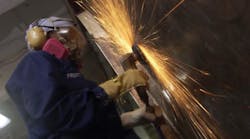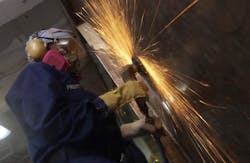Apps across the board
Air tool manufacturers have worked closely with end users to design and develop a range of products that varies in breadth of applicability. Some tools will fit into numerous settings and applications, while others are customized to suit a single task. Regardless of the application, users need cost-effective, reliable, and dependable tools that also provide a safe means of getting work done.
Air tools meet these needs and demonstrate specific advantages over similar tools driven electrically:
Electromagnetic interference — The manufacture of certain products, such as computer chips and components, electrical system components, airframes, telecommunications gear, etc., requires controlled assembly areas to eliminate or reduce possible interference from electric power sources. In these cases, air tools certainly become the desired option.
Continuous use — Because air-tool mechanisms are generally more reliable in continuous-use applications than tools powered by alternative sources, they save cost over time. That’s why all types of fabrication and assembly operations use air tools for fastening, drilling, grinding, and sanding applications.
Ruggedness and durability — Impact damage from operator abuse or difficult job-site conditions can limit tool life and degrade performance. Air tools typically feature a more rugged construction than that of electric and cordless tool alternatives, and can withstand a much higher level of impact damage. As a result, they can be found throughout the mining, construction, demolition, and repair and maintenance fields.
High torque and energy — Often, air tools represent the only option for many applications that require high-torque impact wrenches, high-power grinders, powerful metal and rock drills, and heavy-duty hammers. Such demanding applications include assembly and maintenance of airframes, automobiles, and heavy machinery.
Versatility — Air-tool performance can be controlled somewhat by adjusting input air-pressure levels or by incorporating controls into the tools. Air-tool manufacturers often can customize tools to provide the required level of adjustment to maintain consistent quality and productivity.
Rugged operation — Pneumatic tools can be reversed instantly without harming internal components, which is essential in applications like thread tapping. In fact, these tools may stall under full load before there’s any harm done to components. On the other hand, electric tools can burn the armature or brushes under similar conditions.
Small, powerful, and lightweight —Air tools typically have a higher power-to-weight ratio than electric (especially cordless) tools. A widely accepted rule of thumb holds that every additional pound of handheld weight can result in a productivity loss of up to 7%.
This discussion was provided by Rick Stasyshan, Technical Consultant for the Compressed Air and Gas Institute, Cleveland. For more information on air-tool use and applications, contact CAGI at www.cagi.org.


